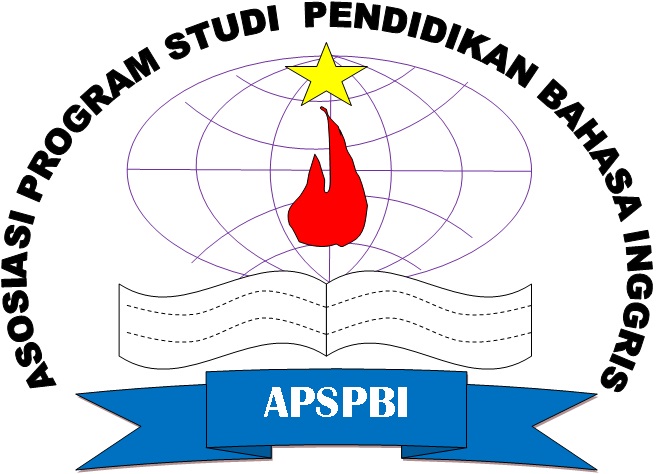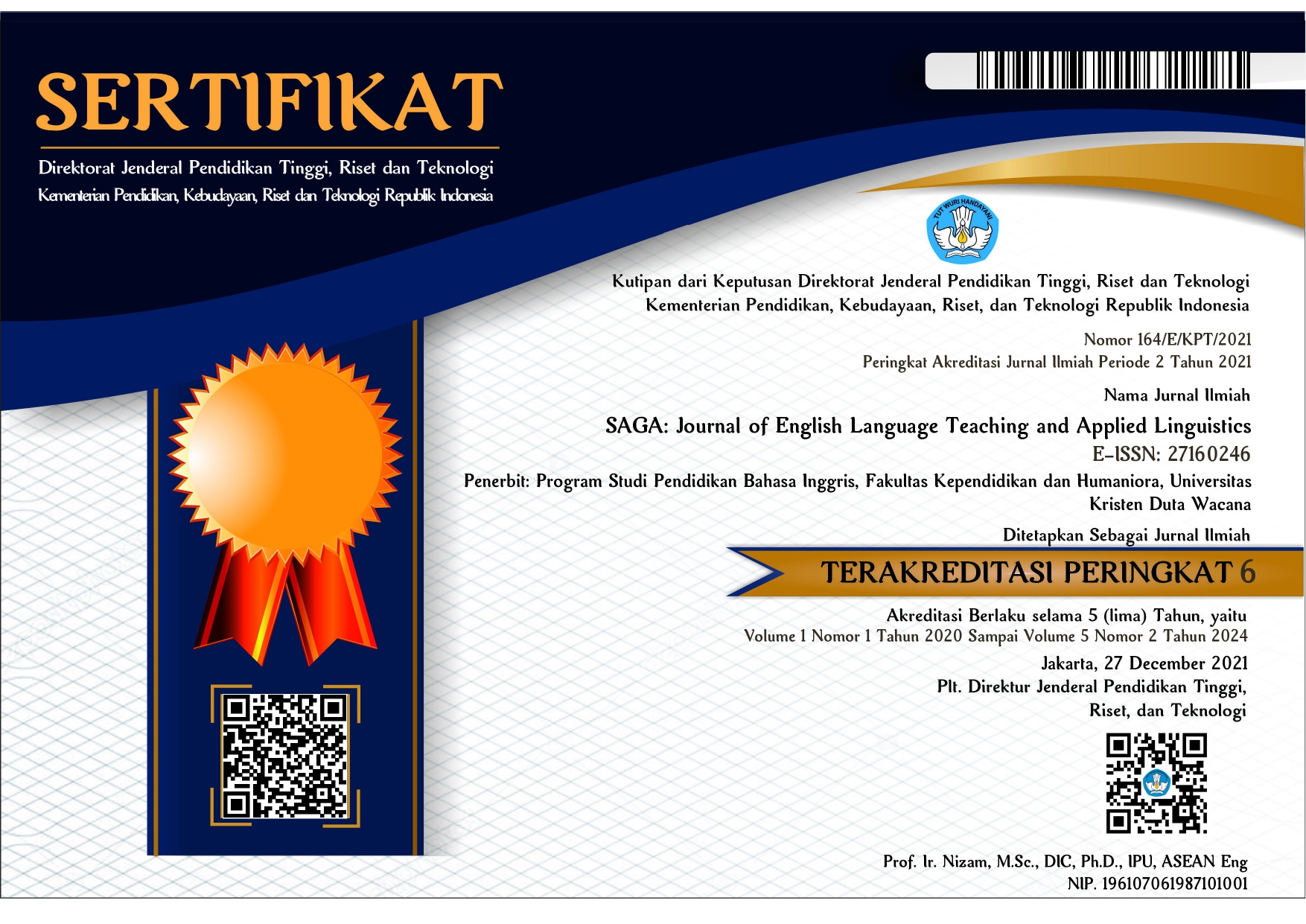English Proficiency of Lecturers at a Private University in Indonesia: TOEFL and CEFR Standards
DOI:
https://doi.org/10.21460/saga.2024.52.198Keywords:
English Proficiency, Lecturers, TOEFL Score, CEFR StandardsAbstract
In the globalization era, it is crucial for lecturers in STIKES Telogorejo Semarang to possess good English proficiency. The proficiency in English can be determined by the score achieved in TOEFL (Test of English as Foreign Language), which is classified based on the standard of CEFR (Common European Framework of Reference for Language). This study aims to identify the English proficiency of lecturers in STIKES Telogorejo Semarang and to determine the appropriate training model to enhance their English proficiency. The data for this article was collected through testing, which was conducted once for the lecturers in STIKES Telogorejo Semarang. The scores were then analyzed using descriptive quantitative methods. The analysis revealed that the level of proficiency in English for lecturers in undergraduate Nursing is A2 Elementary with an average score of 410, for lecturers in undergraduate Midwifery is A2 Elementary with an average score of 394, for lecturers in undergraduate Pharmacy is A2 Elementary with an average score of 439, for lecturers in undergraduate Physiotherapy is A2 Elementary with an average score of 374, and for lecturers in diploma Nursing is A2 Elementary with an average score of 369. Based on the analysis, the suitable training model for lecturers in STIKES Telogorejo Semarang includes listening skills, structure skills, and reading comprehension skills at the Elementary level.
References
Afandi, M., & Khoirin Nashiroh, P. (2020). Pengaruh penggunaan smartphone terhadap prestasi belajar siswa Kelas XI MIPA SMAN 10 Semarang. Jurnal Pendidikan, 8(1), 43-51. https://doi.org/10.36232/pendidikan.v8i1.360
Arifudin, F., & Maryo, A. (2021). The issues of the implementation of CEFR in Indonesia. 5(5), 18-22. http://dx.doi.org/10.30595/aplinesia.v5i1.12080
Badu, H. (2020). Students' ability in reading TOEFL. Jambura Journal of English Teaching and Literature. 1(2), 89-100. https://doi.org/10.37905/jetl.v1i2.7288
Darma, R. N., & Widiastuty, H. (2023). The importance of learning English at school. Jurnal Pengabdian Kepada Masyarakat, 1(1), 23-29. https://doi.org/10.37253/landmark.v1i1.7878
Fahrozy, F. P. N. (2023). Pemahaman membaca dan siswa kesulitan memahami soal cerita matematika di sekolah dasar. Jurnal Elementaria Edukasia, 6(2), 430–441. https://doi.org/10.31949/jee.v6i2.5296
Fitria, T. N. (2021). Students’ ability in the structure and written expression section in the TOEFL Prediction Test. https://doi.org/10.22219/celtic.v8i2.16373
Haq, S. U. (2019). An analysis of English language reading skills of students: A case study. Indonesian TESOL Journal. 1(2), 62-73. https://doi.org/10.24256/itj.v1i2.605
Jayusman, I., Agus, O., & Shavab, K. (2020). Studi deskriptif kuantitatif tentang aktivitas belajar mahasiswa dengan menggunakan media pembelajaran edmodo dalam pembelajaran sejarah. Jurnal Artefak. 7(1). https://jurnal.unigal.ac.id/index.php/artefak
Kamil, D. (2023). Are they finely tuned?: Mapping the CEFR level of the reading texts of the English textbook for grade 10 of Indonesian senior high school. Eduvelop: Journal of English Education and Development, 6(2), 93–102. https://doi.org/10.31605/eduvelop.v6i2.2332
Kharmilah, P., & Narius, D. (2019). Error analysis in writing discussion text made by students at the English department of Universitas Negeri Padang. Journal of English Language Teaching, 8(3). http://ejournal.unp.ac.id/index.php/jelt
Meltareza, R., Wiryany, D., Lubis, I. A. R., Tawaqal, R. S., & Ramdan, A. T. F. (2022). English proficiency training in Bandung orphanages. Inaba of Community Services Journal (INACOS-J), 1(1), 13–24. https://doi.org/10.56956/inacos.v1i1.30
Monny, M. O. E., & Manurung, E. A. P. (2020). Improvement of English grammar understanding using ERWRT for STMIK STIKOM Indonesia’s students. RETORIKA: Jurnal Ilmu Bahasa, 6(1), 85–90. https://doi.org/10.22225/jr.6.1.1528.85-90
Nasucha, Y. (2018). Budaya literasi terhadap pemahaman teks dalam kegiatan berbahasa. In Pertemuan Ilmiah Bahasa dan Sastra Indonesia. Vol. 307. PIBSI) XL.
Oclarit, R. P., & Casinillo, L. F. (2021). Strengthening the reading comprehension of students using a context clue. Journal of Educational Research and Evaluation, 5, 373–379. https://ejournal.undiksha.ac.id/index.php/JERE
Putri, R. E., & Syarif, H. (2021). Students’ needs for TOEFL Preparation Course at university. Proceeding of International Conference on Language Pedagogy (ICOLP), 1(1), 171–182. https://doi.org/10.24036/icolp.v1i1.37
Rahma, A., Dwi Aprilia, P., Alfi Nuari, P., Rahmadian, R., Fatmawati, R. F., & Lestari, S. (2022). Aspek kemampuan menyimak anak usia dini. Jurnal PAUD Emas. 1(2), 18-27. https://online-journal.unja.ac.id/jpe/article/view/18875/13529
Sioco, E. C., & De Vera, P. V. (2018). Grammatical competence of junior high school students. TESOL International Journal, 13(1), 82-94. https://www.elejournals.com/tesol-international-journal/
Smith, R., Snow, P., Serry, T., & Hammond, L. (2021). The role of background knowledge in reading comprehension: A critical review. Reading Psychology, 42(3), 214–240. https://doi.org/10.1080/02702711.2021.1888348
Sosas, R. V. (2021). Technology in teaching speaking and its effects on students learning English. Journal of Language and Linguistic Studies, 17(2), 958–970. https://doi.org/10.52462/jlls.66
Subekti, A. S., Widodo, P., & Andriyanti, E. (2023). Indonesian L2 learners’ CEFR-based listening proficiency: Interactions with attitudes towards teachers’ use of L1. Acta Paedagogica Vilnensia, 50, 37–51. https://doi.org/10.15388/ACTPAED.2023.50.3
Utomo, S., Kusmaryati, S. E., & Sulistyowati, T. (2019). The challenges and difficulties in teaching listening: An exploratory research in a junior high school in Kudus. LANGUAGE CIRCLE: Journal of Language and Literature. 14(1). 27-38. https://doi.org/10.15294/lc.v14i1.19471
















